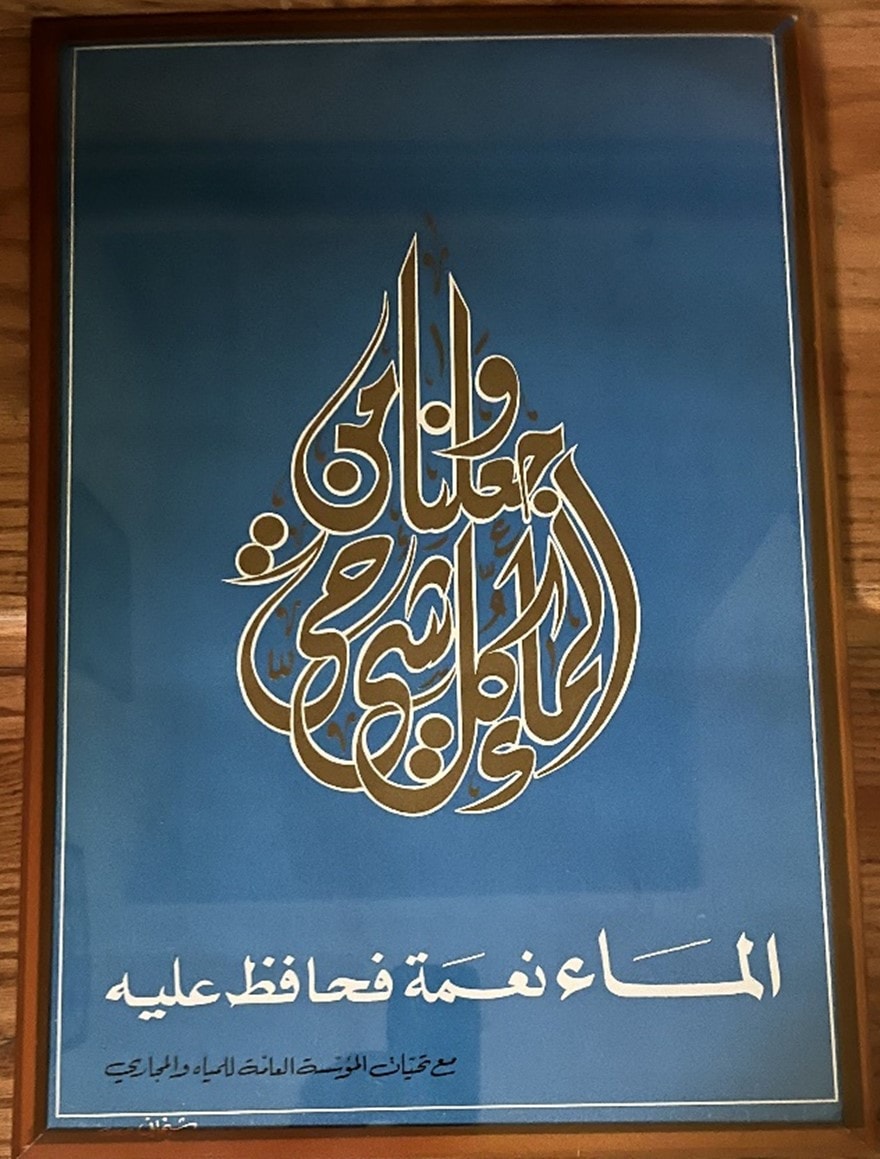When the late Libyan King Idris was told that oil was discovered in his desert kingdom, he sighed: "I wish you told me you discovered water. Water makes people work; oil makes them dream."

Top: "We made from water every living thing [Quran 21:30]"
Below: "Water is a blessing; preserve it."
Introduction
On July 11, 2007, in a briefing to the staff of the Foreign Relations Committee of the U.S. Senate on "Potential Water Conflicts in the Middle East,"[1] identifying this emerging crisis early on, the author of this report made, inter alia, the following points regarding water scarcity in the Middle East:
The Middle east is the world's most water-stressed region. Most of the region's countries cannot meet current water demand;
The average availability of water is 1,200 cubic meters (CM) per person per year, projected to be halved by 2050 (this compares to a global average of 8,900 CM per person per year today [2007] and about 6,000 CM per person per year in 2050;
Aquifers are over-pumped and water quality is deteriorating, with consequences for human health, agricultural productivity and the environment;
Unreliable water services are prompting people to migrate in search of better opportunities;
And about 60 percent of the region's water is transboundary, i.e., water which flows across international borders, leaving a number of countries, including Egypt, Iraq and Syria to be affected by decisions made upstream by riparian countries. The dependency ratio i.e., the share of the total renewable water sources originating outside the country: Egypt (96.9 percent), Syria (80.3 percent) and Iraq (53.3 percent)
A Study By The World Bank On The Economics Of Water Scarcity
The World Bank issued, on April 27 of this year, a comprehensive study addressing in much greater detail and analysis extending over 200 pages of text, charts, tables and footnotes the issues highlighted in the introduction.[2] The study, carried out by four senior economists of the World Bank, highlights three central issues: the current situation of water demand and availability, projections through 2050, and the performance of the institutions involved in the management of water resources and how they should be shaped to deal with emerging strategic water shortages.
According to the study, countries in the Middle East and North Africa (MENA) are some of the most water scarce in the world in addition to being the hottest and driest countries. They have experienced diminishing inflows of water along shared rivers and shared aquifers. The study warns that population growth and climate change will only exacerbate the problem of water scarcity. Indeed, the population grew from just over 100 million in 1960 to more than 450 million in 2018 and it is expected to grow to about 720 million in 2050.
Most populous countries in the region – Iraq, Syria, Egypt, and Morocco – have sizable agrarian populations and are home to over 70 percent of the region's rural population of 167 million. These countries channel more than three-quarters of their water withdrawal to agricultural irrigation.
The study estimates that by 2030, average annual per capita water resource availability across MENA will fall below the absolute water scarcity threshold of 500 CM per person per year. The study asserts that within the next decade all the countries in MENA will fall below the water scarcity threshold of 1,000 CM per person per year. It further warns that water withdrawals are far greater than available renewable resources and diminishing sources of supply unlikely to be replenished by rainfall. The study estimates that water demand in 2050 will require an additional supply of 25 billion CM per year, equivalent to building 65 desalination plans the size of the Ras Al-Khair in Saudi Arabia, currently the largest in the world.
Of course, desalinization is not cost-free in terms of environmental harm. Desalination plants discharge large quantities of brine, a salty material, which increases the salinity of the sea water. Fishing becomes a major casualty. Fishermen have complained about the decline in the quantity of fish in the Persian Gulf attributed to the many desalination plants operated by the Gulf countries, primarily Saudi Arabia and UAE. The desalinization capacity is greatest in MENA with 46 percent compared with 13 percent in the U.S. and eight percent in Western Europe.
The nature of population growth has significant implications on water consumption. The urban population grew from 40 million in 1962 to 300 million in 2020. Urbanization brings about a change in lifestyle, and urbanized populations would likely consume more water per capita than the traditional rural population, causing additional stress on the demand for water. The study points out that both Gaza and the West Bank are highly urbanized, with more than three-quarters of the population living in towns and cities. Agriculture is declining as a source of livelihood.
Management Of Water Resources
Making an interesting point, the study reads: "Throughout history, institutions for investing and managing large-scale irrigation water [projects] have been linked to centralized forms of power – pharaohs, sultans, emperors, kings, colonial administrations, and post-independence central government." The focus on large infrastructure projects, particularly dams, has expanded the role of central governments in the management of water plants.
The study highlights considerable discrepancies between supply and demand of water. Induced by the availability oil revenues as well as of loans on concessional terms by international organizations such as the World Bank, most governments in the region have invested considerable financing in the construction of dams and major water projects whose construction, while costly, carries a large amount of prestige for rulers. By contrast, the countries fell behind in the demand side, namely building the infrastructure necessary to channel water where it is most needed whether in agriculture or for urban consumption.
Fearing political revolt and political instability, most governments have been reluctant to raise the price of water to reflect the real cost of production and at the same time to encourage an efficient use of scarce resources and discourage waste. Tapping illegally into water pipelines, Inefficient or corrupt enforcement of billings and collection of bills due add a heavy burden on the management of water resources. Enforcement of water regulations often runs into a strong resistance by the users. The study provides an example in Jordan where water regulations officials were driven out by villagers when they tried to close illegal wells. As a result, the contribution of each cubic meter of water to gross value added of irrigated agriculture ranges from less than $0.10 per CM in Libya to more than $2 in Israel, making it 20 times the difference. Total water productivity in MENA is only about half of the world's average.
Virtual Water
In order to meet the growing demand for water in the future, the study makes quite a large number of recommendations. They include more efficient use of water in agriculture, economic pricing to discourage waste, more efficient water management institutions, and continued reliance on virtual water.
Virtual water is the hidden flow of water in cereals and other commodities that are traded from one place to another. Egypt, for example, is the largest importer of wheat in the world. It takes 11,000 gallons of water to grow a bushel, or approximately 60 pounds, of wheat. Traditionally, the farming of rice needs 3,000 to 5,000 liters of water to produce a kilo of rice, and about 135,000 gallons of water to produce a ton of alfalfa used for livestock feed. Saudi Arabia is one of the largest importers of alfalfa. Virtual water imports in MENA – water imported within food and other agricultural commodities doubled to 255 billion CM between 1998 and 2010. Considering that the amount of water flowing through the Nile River is about 300 million CM, the virtual water flowing into the MENA through agricultural and other commodities is about equal to the entire flow of water in the Nile River in a decade. By relying heavily on virtual water, MENA countries save a huge volume of water that would have been needed and in some cases unavailable in sufficient quantity, to grow commodities locally to feed a large and rapidly growing population. The study points out, however, that reliance on virtual water imports exposes countries to supply shock, such as the recent war in Ukraine.
Conclusion
The authors of the study conclude with these general observations: "…water is becoming increasingly scarce in the MENA region…and current demand trajectories are outstripping supply. Available renewable water resources are overallocated across consusmptive uses (agriculture, cities, and industry). While the key drivers of water scarcity are related to demographic and economic growth, the cost of climate-related inaction is much higher in MENA than in other regions of the world. Continuing along the current path of waste management and allocation could cost the region between 6 and 14 percent of gross domestic product (GDP) by 2050 – compared to a global average of reduction of GDP of less than 1 percent by 2050."
Water, not territory or refugees, could be the major source of conflict in the Middle East and North Africa. Most countries in MENA draw on water from across their borders. Rising populations in both upstream and downstream countries coupled with climate change, pollution, and rapidly growing urbanization will place great pressure on diminishing water resources, and perhaps trigger military conflicts. Not far down the road, the region might be confronted with what the United Nations has characterized as "water refugees," those whose land has gone under water and those who cannot find water to drink.
* Dr. N. Raphaeli is Senior Analyst Emeritus at MEMRI
[1] See MEMRI Inquiry & Analysis No. 367, Potential Water Conflicts in the Middle East, July 11, 2007.
[2] The World Bank, Overview: The Economics of Water Scarcity in the Middle East and North Afrrica—Institutional Solutions," by Dominick de Waal et.al. Washington/Rabat, April 27, 2023.





